Recently updated on May 7th, 2025
The key difference between LMSs and other online training platforms that are well-suited to creating, delivering, and selling online courses is that LMSs, in particular, need to contain features that help users—whether they are businesses that rely on selling courses as their main income stream, or individual creators—sell and monetize their courses.
Many LMS platforms, though, can lack these features, and are set up more for internal training or educational institutions, often falling short in key areas.
These shortcomings include weak e-commerce integration (lacking flexible pricing, payment gateways, and coupon management), limited marketing functionality (impacting lead generation and sales), inflexible course packaging (hindering bundles and subscriptions), reporting gaps (missing crucial sales and marketing analytics), and cumbersome content creation tools (making course development slow and difficult).
It’s with all of this in mind that we’ve created this guide which walks you through the features you should look out for if you’re looking for an LMS or other online learning platform to create and deliver your online courses.
We begin with a walkthrough of the key features to consider, and then take a look at our solution Arlo, an all-in-one training platform that has all the features you need to create, schedule, deliver and sell in-person, virtual, blended and eLearning courses, plus seven other notable options.
Let’s jump in 👇
Key Features an LMS for Online Courses Should Contain
1. Ability to Create and Host Elearning as Well as Blended Courses
An LMS for online courses should allow instructors to create, manage, and deliver online and blended training.
This can encompass several approaches: some platforms include built-in eLearning authoring tools, enabling the creation of custom courses; others offer or integrate with course libraries, providing access to pre-made content that can be delivered (and potentially resold, depending on the licensing agreement); and many support a combination of both.
A key advantage of an LMS with built-in eLearning authoring capabilities is its ability to facilitate blended learning.
By having the capability to create custom eLearning modules, instructors can integrate online components with traditional in-person instruction whether hosted live or physically.

2. E-Commerce & Payment Integration
An LMS for online courses should provide built-in tools for selling courses or integrate with external payment systems. Course creators need the ability to manage pricing, offer flexible payment options, and automate transactions without relying on third-party workarounds.
More specifically these ecomm features should look like:
Course Pricing and Payment Options
- Support for one-time payments, subscriptions, installment plans, and course bundles.
- Ability to offer discounts, coupons, and promotional pricing.
- Integration with major payment processors like Stripe, PayPal, and regional gateways.
Sales and Revenue Tracking
- Dashboard for monitoring sales, refunds, and revenue trends.
- Detailed reports on learner purchases, payment status, and enrollment trends.
- Automatic invoicing and tax calculation based on location.
Checkout and User Experience
- Customizable checkout pages with branding and upsell options.
- Secure transactions with fraud protection and compliance with local regulations.
- Ability to enroll learners immediately after payment with automated confirmations.
A strong eCommerce system inside an LMS removes friction from the sales process and allows course providers to focus on content rather than managing payments manually or through disjointed, non-aligned platforms.
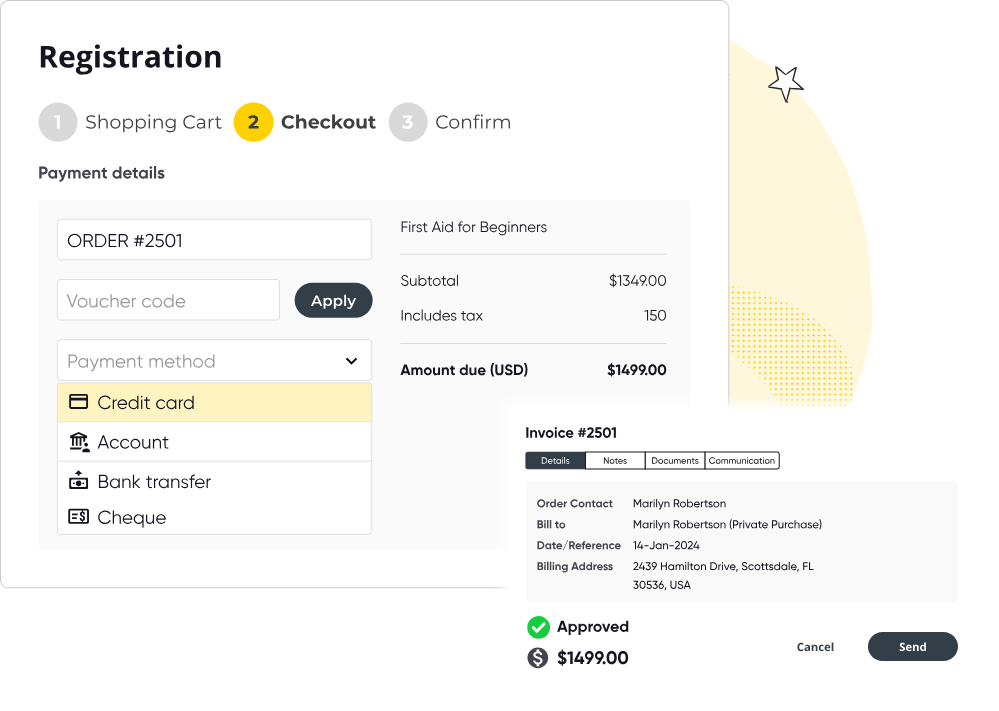
3. Learner Engagement & Interactive Features
An LMS for online courses needs more than just static content. You need to be able to create engaging courses that keep learners interested, improve retention, and encourage participation.
A system that supports interactive elements helps create a more effective learning experience.
Interactive Course Content
- Support for quizzes, assignments, and knowledge checks to reinforce learning.
- Scenario-based learning and simulations to provide real-world applications.
- Video tutorials with embedded questions or discussions to keep learners involved.
Communication and Collaboration
- Discussion forums and community spaces for peer interaction.
- Live chat, messaging, or instructor Q&A sessions for real-time engagement.
- Integration with webinar tools for live sessions and virtual classrooms.
Gamification and Progress Tracking
- Badges, leaderboards, and point systems to encourage participation.
- Certificates for course completion to provide learners with tangible achievements.
- Progress tracking with clear milestones to keep learners motivated.
4. Marketing & Lead Generation Tools
To sell courses effectively through an LMS the platform needs to have built-in marketing tools or integrations that make it easier to attract potential learners and convert them into paying customers.
Without effective marketing features, even the best courses can struggle to reach the right audience.
These features can look like:
Course Promotion and Sales Funnels
- Customizable landing pages to showcase courses with detailed descriptions, pricing, and benefits.
- Lead capture forms to collect email addresses for follow-ups and promotions.
- Automated email sequences for abandoned carts, course recommendations, and special offers.
Integrations with Marketing Platforms
- Direct integrations with email marketing tools like Mailchimp, ActiveCampaign, or HubSpot.
- Support for tracking pixels and analytics tools like Google Analytics and Facebook Pixel for ad performance tracking.
- CRM integrations to manage leads, track customer interactions, and personalize outreach.
Referral and Affiliate Programs
- Built-in affiliate system to allow partners to promote courses for a commission.
- Referral discount options to incentivize word-of-mouth marketing.
- Unique tracking links to monitor affiliate and referral performance.
5. Website and Online Store Integration Options
The LMS should integrate with your existing website if you already have one selling your online courses.
For example, Arlo integrates with existing training and course websites, so in essence your using Arlo as your backend – the place where you create and set-up all your courses, registrations and logistics, and then publishing these courses to your website rather than manually setting them up in two places.
The other option you might come across is integration options with eCommerce platforms like Shopify or WooCommerce.
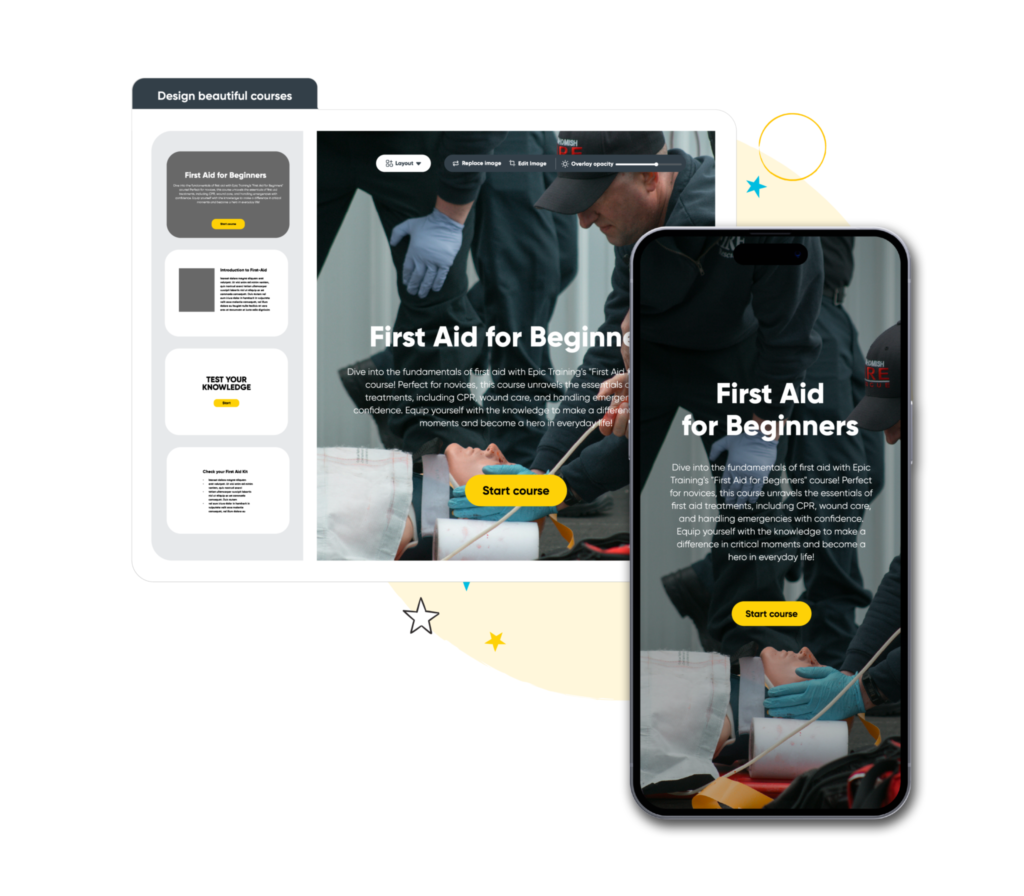
6. Analytics & Learner Progress Tracking
Tracking learner performance is essential for improving course content and identifying areas where students struggle. An LMS should provide clear insights without requiring manual data collection.
- Real-time reports on enrollment, completion rates, quiz scores, and engagement levels.
- Custom dashboards to track learner progress across multiple courses.
- Automated alerts for at-risk students who may need additional support.
7. Integration with Other Tools & Platforms
As mentioned above, the LMS should connect with the other key platforms in your tech stack, including video conferencing tools like Zoom (if you deliver virtual training or want virtual sessions as part of your online course), marketing tools, CRMs, and payment gateways for course sales and lead management.
For custom workflows, API access or Zapier integration is also essential.
Now you know some of the key features to look out for, let’s take a look at some options 👇
6 of the Best LMS for Online Courses
1. Arlo
Arlo is an all-in-one training platform with all the features you need to create, manage, deliver and sell in-person, virtual, blended and eLearning training.
If you’re more of a visual learner you can check out a quick 15-minute walk through of Arlo’s key features below, or read on for an overview.
Arlo features you need to be aware of:
eLearning Authoring, Delivery, and Hosting
With Arlo, you have the tools to create and design engaging eLearning content. There are three-ways you’ll be able to do this:
- Document to Course – Upload and convert existing documents into interactive courses.
- Generate a Course with AI – Enter a description of your course into Arlo’s AI assistant, select your tone, style, fonts, colors, and branding, and watch as your course is created before your eyes.
- Build Your Course from Scratch – Use Arlo’s course and quiz templates to create your course from the ground up.

Here’s how these options work:
1. Document to Course
Step 1: Prepare Your Document
Arlo supports various file formats, including Word documents, PowerPoint presentations, and PDFs. If your content is stored on an external platform, export it as a PDF to get started.
Step 2: Upload Your Document and Choose a Course Style
Upload your file to Arlo and select a course style that aligns with your objectives. Whether you prefer a concise layout, a focus on key information, or a more creative design, you can customize the tone and appearance to suit your needs.
Step 3: Transform Your Document into an Interactive Course
Let Arlo do the heavy lifting as it converts your document into a fully interactive course. Once the transformation is complete, review the content, adjust layouts, add multimedia, or further customize the course to meet your vision.

2. Generate a Course with AI
Step 1: Provide Input to Arlo’s AI Assistant
Share the details of what you want your course to cover with Arlo’s AI assistant. The more specific and detailed your input, the more tailored and relevant your course will be.
Step 2: Choose Your Style, Tone, and Theme
Select from a variety of styles, tones, and themes to customize your course. Finish it off by applying one of Arlo’s professionally designed course templates to create a polished, cohesive look.


Step 3: Watch Your Course Come to Life
Arlo will build your course section by section based on your input. As the content comes together, you can review it, make edits, and refine it to ensure it aligns perfectly with your goals.

3. Build Your Course from Scratch
Step 1: Design and Structure Your Course
Begin by outlining your course using Arlo’s intuitive interface. Organize your content into sections or modules, and add multimedia elements such as videos, downloadable resources, and interactive activities to create a solid foundation.
Step 2: Customize Your Style and Theme
Tailor the appearance of your course to align with your brand and teaching style. Select from a range of templates and themes to create a cohesive, professional look. Adjust colors, fonts, and layouts to reflect your objectives.
Step 3: Add Assessments and Quizzes
Include quizzes and assessments to reinforce key concepts and measure progress. Arlo’s AI assistant can generate quiz questions directly from your course content, helping you save time and ensure alignment with your learning goals.
Step 4: Enhance Engagement with Interactive Features
Incorporate interactive elements like flashcards, infographics, gamified challenges, and practical activities. These features keep learners engaged and help them retain knowledge more effectively. Arlo’s tools make it easy to create a dynamic and impactful learning experience.

Course Management and Registration
Once you’ve created an eLearning course within Arlo you can schedule it as a standalone self-paced course or as a module within a blended course.
You can choose to set up the course as a ‘new course’ from scratch or use Arlo’s library of course templates.
When you create a new course using a template it will be automatically generated, pre-filled with key information that you can edit and save such as pricing, location, dates and more.
You can then re-use the template as many times you like, making it easy to schedule repeat courses on multiple dates and locations.
Courses support face-to-face, live-online, blended, and eLearning formats, giving you the flexibility to deliver your learning in the format most beneficial to your learners, and the flexibility to set up a course to be a one-off, multi-session, or recurring.
If you’ve run the course before you can select ‘I have run this course before and would like to schedule another’ for quick scheduling.

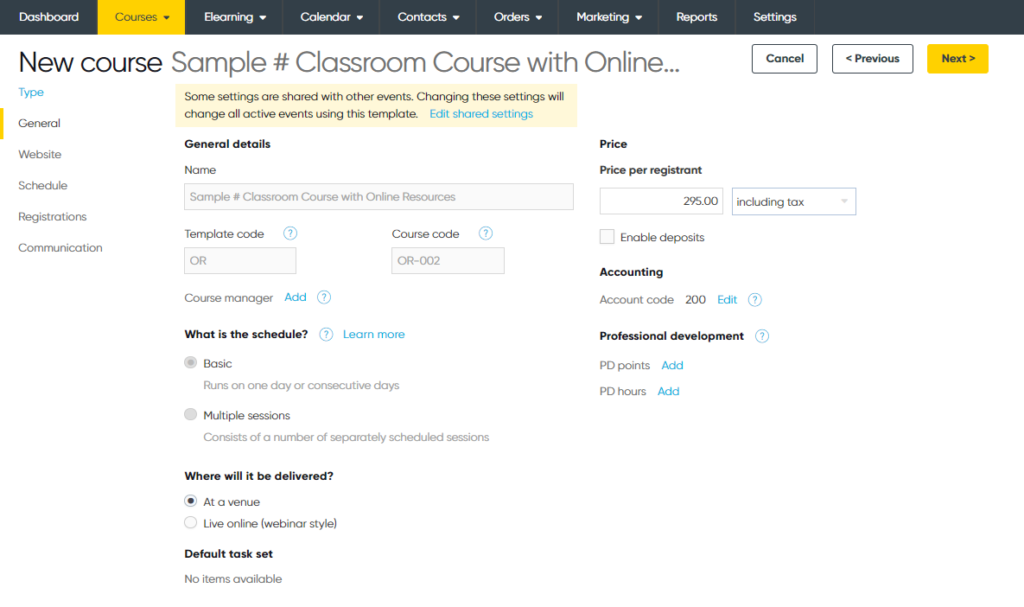
After setting up your course, the next step is managing registrations. Arlo provides pre-designed templates for public and private courses, accommodating both paid and free options.
For paid courses, the registration process is fully automated. Upon registration, the system immediately sends a payment confirmation (or invoice) via email, followed by a separate email containing comprehensive course details.
Free course registration is streamlined with a simple one-page form. A confirmation email containing all relevant course information is automatically sent to the registrant.
To make life easier for registrants, they can sign-up for or multiple courses and add multiple participants within a single form. Configurable options include voucher codes, payment method selection, and other relevant details.
Arlo also gives you granular control over each registration form. Set screening rules, manage waitlists, and define registration limits to ensure optimal class sizes.
Flexible payment options are supported, including credit card, invoice, and bank transfer. Arlo integrates with leading payment gateways such as Stripe, PayPal, Apple Pay, Google Pay, Klarna, Afterpay, and Windcave, facilitating secure and easy transactions.
Discount codes can be configured, registration limits can be set, and waitlists can be managed. When a course is full, registrants can join a waitlist and are automatically enrolled should a spot become available.
Upon successful payment, invoices and receipts are automatically generated and distributed to registrants. Integration with accounting platforms like Xero and QuickBooks simplifying your billing process financial management.
Within Arlo you can also manage transfers, refunds, and cancellations. Administrators can easily process these changes and automatically notify affected customers.
Furthermore, registrants can be empowered to self-manage cancellations or transfers through a self-service portal should you wish to configure one.
Set-up Your Course Communications
Once you’ve set up your course and the registration forms, you can set up all the relevant communications.
This includes setting up instructor confirmation emails (if required), venue booking confirmation emails (if needed), registration confirmation emails, reminders and more.
You can also set up any pre and post course emails to registrants. For example, you might want to send pre-reading materials pre-course, and surveys or certificates post-course, all of this is available through Arlo.
In addition to this, you can also set up course registration reports, attendance reports, and financial reports to be sent to relevant stakeholders after the course has been delivered.
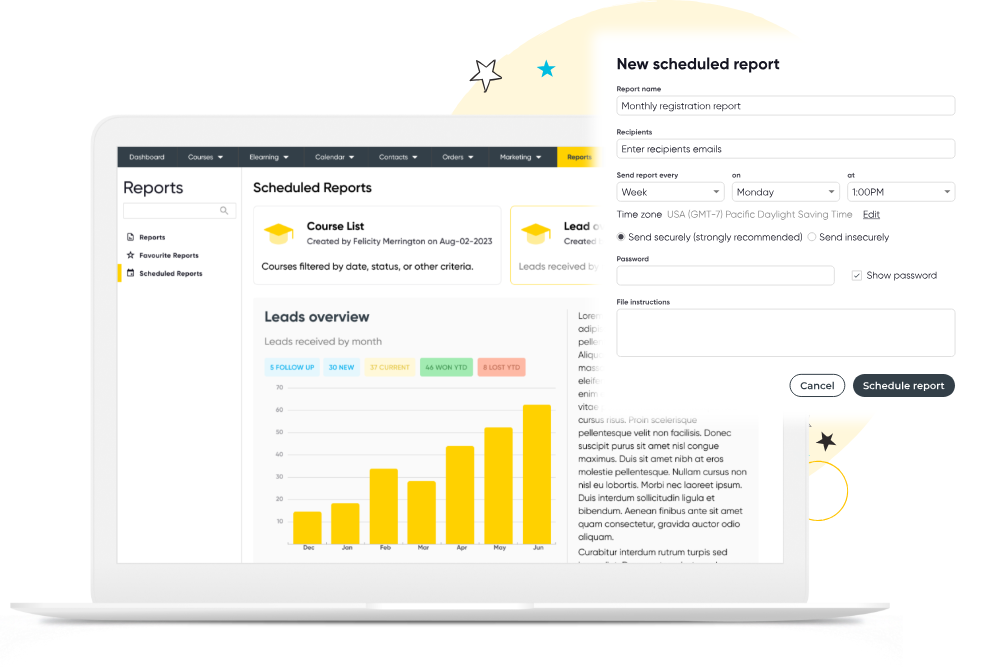
Publish the Course to Your Website
Once all this is done its time to publish the course to your website.
When you’ve set up your course all the logistical details, the communications, you’ll be brought to a publishing page where you can select input your course description, add a summary, set the duration of time you want the course to advertise for, and other details.


You also have complete control over the branding, formatting, and layout of your courses on your website. All of this can be configured within Arlo before publishing and edited afterwards if you want to make any changes.
When you hit publish the course will be immediately displayed on your website, ready to take registrations.

In addition to all of the above, Arlo contains a host of other features that help you keep tabs on every aspect of your course management and performance:
Real-Time Dashboards – get instant visibility into upcoming courses, registrations, and revenue, and you can easily drill down to take action.
You can track and manage upcoming courses and their availability. You can also monitor all your registrations and see details of sign-ups as your courses go live.
The platform also shows you orders and revenue trends, highlighting any outstanding invoices or approvals. Finally, you can view a breakdown of leads by month, see trends, and manage and complete your daily tasks.

In-Built CRM – Manage all your important relationships in one place. Arlo’s in-built CRM manages your key relationships by automatically storing contacts and tracking course activity and outcomes.
It captures and nurtures your leads, providing you with access to certificates, documents, and other relevant files. You can easily manage lead, registration, and organization data. A complete communication history is maintained, along with associated certificates, documents, and contracts.
You can use customer data and custom fields to trigger automated actions and campaigns. Real-time synchronization with leading CRM’s such as Salesforce integrates your contacts, organizations, and course information.

Tools to Market Your Courses – Marketing tools are included to help increase training sales. These tools facilitate running targeted campaigns to drive leads and registrations and provide ROI tracking.
You can build smart lists filtered by criteria such as course activity, renewal date, location, and custom fields. Targeted email campaigns can be used to promote courses, with activity monitoring and results tracking.
Automated surveys can be sent to gather feedback and improve course content. Integrations with Google Tag Manager, Google Analytics, Meta, SurveyMonkey, Mailchimp, and other platforms are supported.

Next Steps to Take
As you can see, Arlo is a platform packed with features to help you design, create, deliver, manage, and sell all your online courses. Of course, reading about a platform is one thing, but trying it out is another.
You can start a free 14-day trial with Arlo below, or, if you want to see how Arlo can be personalized to your own workflow, you can book a demo with our friendly team.
Get your time back, increase training revenue, and deliver better training with Arlo. Start a free 14-day trial today.
2. TalentLMS
TalentLMS is a flexible learning management system designed for businesses, training providers, and educational institutions that need an easy-to-use platform for course creation, learner management, and online training delivery.
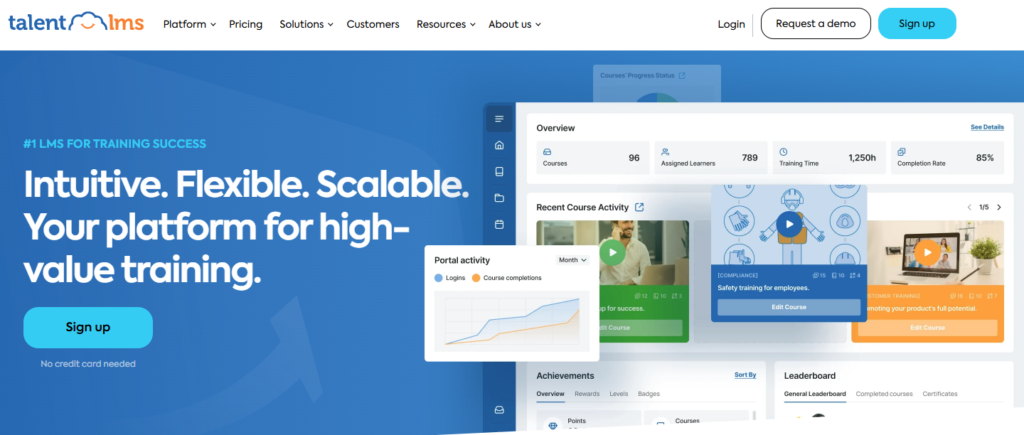
It offers a modern interface with AI-assisted course development, making it easy to create structured, visually appealing training content.
The system is designed for both internal employee training and external learner programs, supporting onboarding, compliance, and professional development courses.
The platform provides a customizable learning environment, allowing organizations to brand their training portals, organize users into groups or branches, and manage access based on roles or departments.
TalentLMS supports self-paced learning, instructor-led training, and blended learning, making it adaptable to different training models.
Key Features for Online Courses
AI-Powered Course Creation – TalentCraft course library helps users build courses quickly with structured layouts, media integration, and interactive elements.
Learner Management & Customization – Organize learners into groups, assign learning paths, and customize portals for different teams or departments.
Gamification & Engagement – Badges, leaderboards, and quizzes enhance learner motivation and completion rates.
E-Commerce & Payment Integration – Sell courses with Stripe and PayPal support, offering flexible pricing, subscriptions, and discount options.
Analytics & Reporting – Pre-built and custom reports track learner progress, completion rates, and revenue, though reporting customization is somewhat limited.
Website & API Integration – Works with WordPress and external websites via API for course catalogs and registration management.
Multi-Device Access – Fully responsive design for desktop and mobile learning, though some features require a desktop for full functionality.
Pricing
TalentLMS offers a free plan for small teams, with paid plans starting at $119 per month. Higher-tier plans provide additional user capacity, automation features, and advanced analytics.
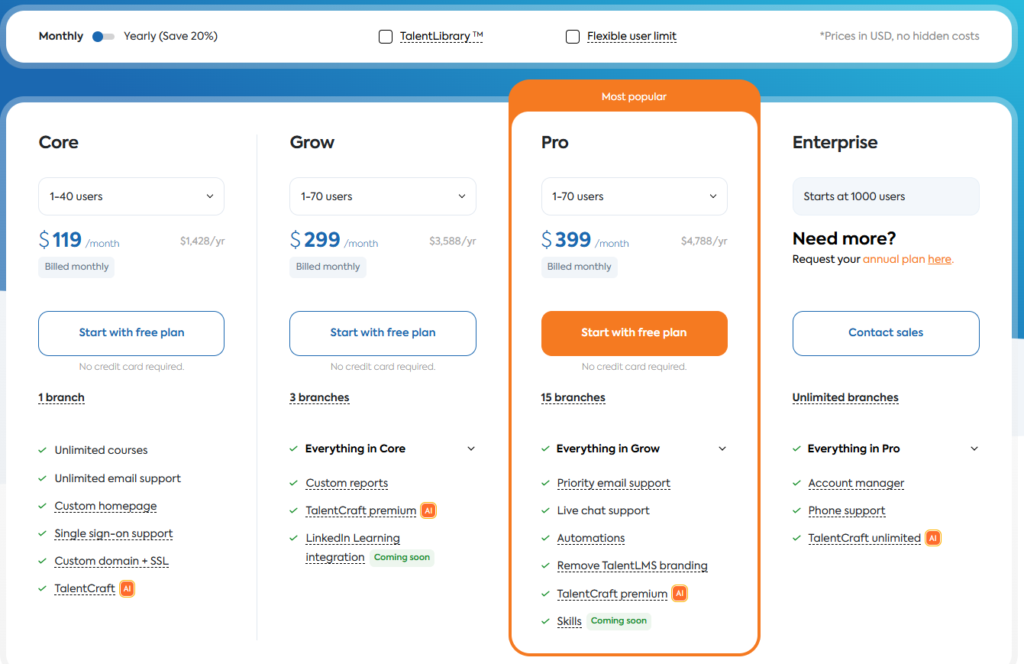
G2 Score
TalentLMS holds a 4.6/5 rating on G2
3. LearnWorlds
LearnWorlds is built for course creators, coaches, and businesses looking to sell and deliver interactive online courses.
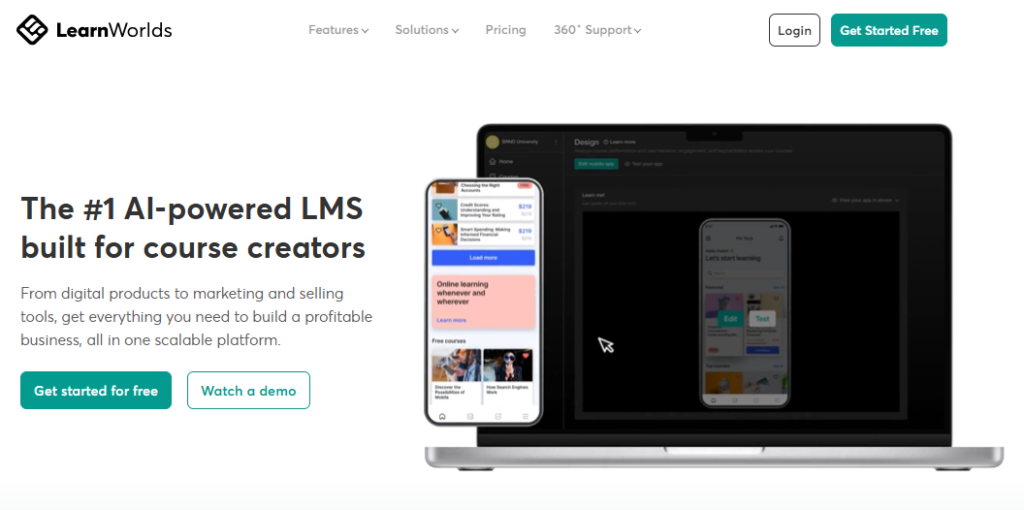
Unlike many LMS platforms that rely on static SCORM packages, LearnWorlds provides an all-in-one course creation, hosting, and e-commerce solution
The platform allows users to build fully customized learning experiences without needing third-party tools, making it a self-contained system for content development and monetization.
A standout feature is interactive video learning, which allows quizzes and call-to-actions to be embedded within videos, helping to boost engagement and retention. The platform also includes a website builder, enabling course creators to host their courses, create landing pages, and manage sales funnels without relying on external software.
LearnWorlds supports subscriptions, memberships, and one-time purchases, making it ideal for those who want full control over course pricing and sales strategies.
Key Features for Online Courses
Course Creation & Delivery
- Drag-and-drop course builder with support for videos, quizzes, assignments, and PDFs.
- Interactive video functionality, allowing quizzes and call-to-actions within video content.
- Supports live teaching sessions via Zoom and Webex integration.
- Drip-fed content scheduling to manage course pacing.
E-Commerce & Monetization
- Built-in course sales tools, including subscriptions, memberships, and one-time purchases.
- Affiliate marketing system for referral-based course sales.
- Coupons and discount management for promotional campaigns.
- Supports multiple currencies and payment gateways, including Stripe and PayPal.
Customization & Branding
- Fully white-labeled, allowing users to customize the platform with their own branding.
- Custom domains, website builder, and advanced site design options.
- Multi-language support for global course delivery.
Learner Engagement & Community Features
- Integrated discussion boards and community spaces for student interaction.
- Gamification features, including badges and progress tracking.
- Built-in messaging and notification tools to engage learners.
Pricing
LearnWorld has four plans available:
- Starter – $29/month
- Pro Trainer – $99/month
- Learning Center – $299/month
- High Volume & Corporate – Contact Sales.
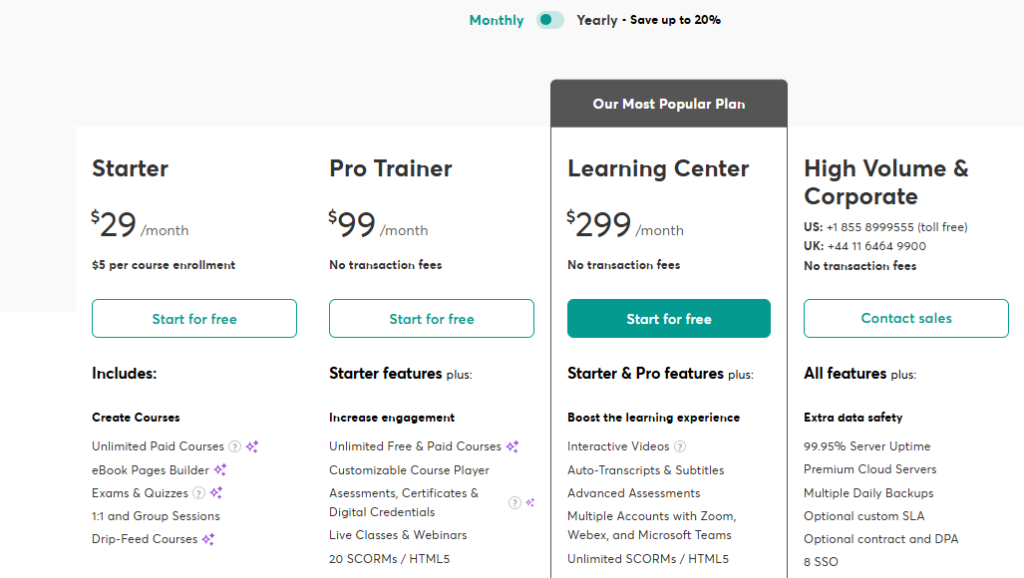
G2 Score
LearnWorld is rated 4.7/5 based on 359 G2 reviews
4. Thinkific
Thinkific is a course creation and e-commerce platform designed for entrepreneurs, educators, and businesses looking to build, market, and sell online courses.

While it does not function as a traditional learning management system (LMS) with features like corporate training, compliance tracking, or extensive reporting, it provides a user-friendly solution for individuals and organizations looking to monetize their knowledge through online learning.
The platform enables users to create professional-looking courses without requiring coding or design expertise.
Thinkific offers a drag-and-drop course builder, multimedia support, and customization tools that allow creators to design branded course websites. It also provides built-in e-commerce functionality, making it easy to accept payments, sell memberships, and bundle courses for different pricing models.
A key differentiator of Thinkific is its focus on scalability and customization. Users can integrate Thinkific with marketing tools, automation platforms, and CRM systems, enabling them to build a seamless sales funnel for their online courses.
Key Features for Online Courses
Course Creation & Customization
- Intuitive drag-and-drop course builder supporting various multimedia formats.
- Customizable course websites with a selection of ready-made, responsive themes.
- Options for drip scheduling to control the release of course content.
E-Commerce & Monetization
- Integrated payment processing through ECommerce, offering tools like order bumps, gifting, and flexible payment methods to enhance sales.
- Ability to set up one-time payments, subscriptions, memberships, and bundles.
- Access to the Thinkific App Store for additional integrations to support payment gateways, marketing, and automation.
Student Engagement & Community Building
- Incorporation of quizzes, assignments, and completion certificates to assess and motivate learners.
- Built-in discussion forums and community spaces to foster interaction among students.
- Integration with Zoom for live lessons and virtual events.
Marketing & Growth Tools
- Affiliate and referral program management to expand course reach.
- Tools for creating sales funnels and capturing leads to boost conversions.
- SEO-friendly course pages to improve visibility in search engines.
Pricing
Thinkific has three pricing plans available, with a 14-day free trial available for each:
- Basic – $36/month
- Start – $74/month
- Grow – $149/month
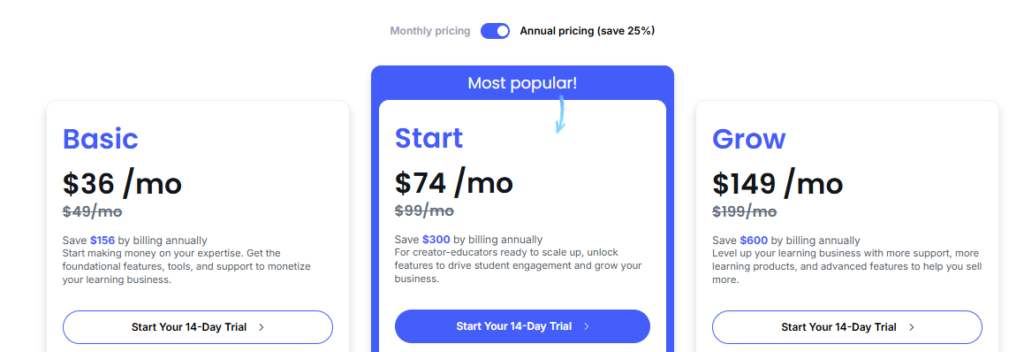
G2 Score
Thinkific is rated 4.5/5 based on 298 reviews.
5. Kajabi
Kajabi is a popular all-in-one online training platform designed for entrepreneurs to build, market, and sell online courses. It handles course creation, hosting, marketing, sales, community features, and website management, consolidating these functions into a single platform.

The platform is user-friendly for course setup and management, offering features like on-demand video hosting and built-in assessments. While advanced customizations may require expert help, core course creation is generally intuitive.
Marketing and sales tools, including landing page creation, email automation, sales funnels, and affiliate tracking, are integrated, so creators can create, manage and sell their online courses through the platform. Community building is also supported through live sessions and forums.
Key Features for Online Courses
All-in-One Platform – Kajabi’s strength is its comprehensive nature, combining course creation, marketing, sales, and community tools in one platform
Simplified Course Building – Kajabi prioritizes ease of use for course creators, offering templates and intuitive tools for structuring content and delivering courses.
Integrated Sales and Marketing –Kajabi provides built-in tools for sales funnels, email marketing, and landing pages, directly connected to the course platform, streamlining the process of selling courses.
Pricing
Kajabi has for plans available:
- Kickstarter – $89/month
- Basic – $149/month
- Growth – $199/month
- Pro – $399/month

G2 Score
Kajabi is rated 4/5 based on 80 reviews.
6. Moodle
Moodle LMS has a host of different use cases including workplace training, vocational training and more. Inside the platform you can set up elearning courses, host them, ready for your learners to access.
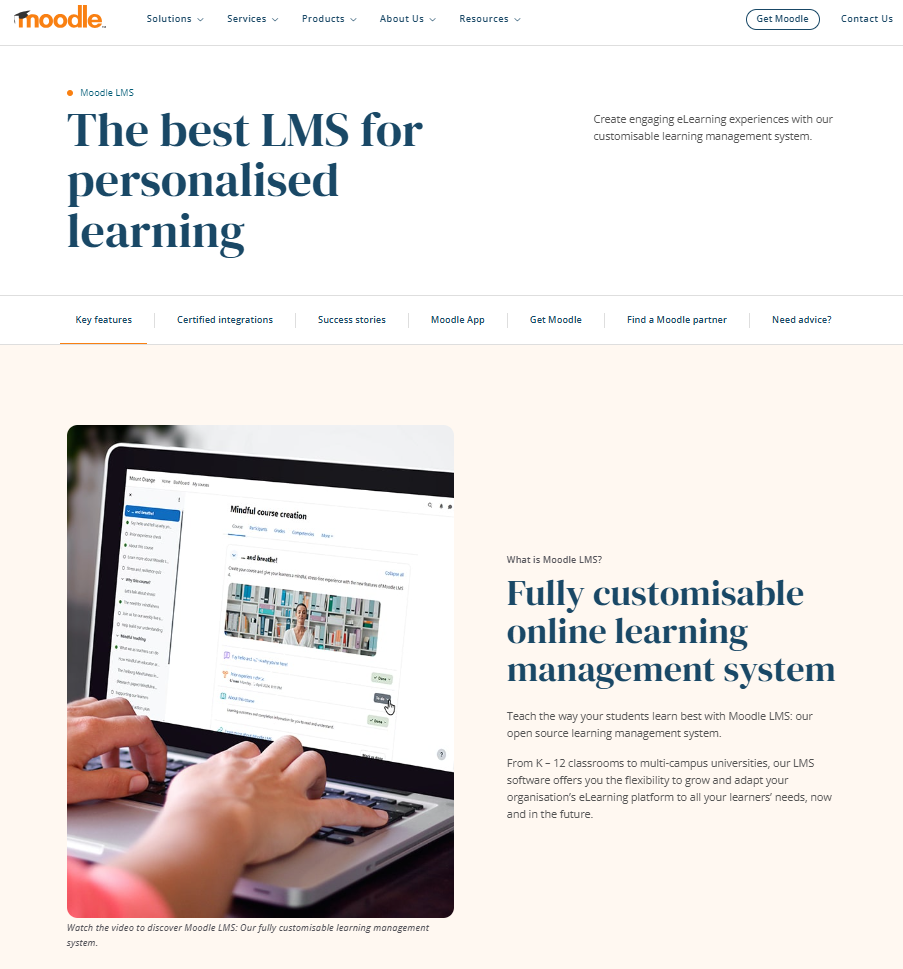
If you want to sell your eLearning then you’ll need to connect Moodle to a payment provider or ecommerce system. One option you can consider is integrating Moodle with Arlo.
When you integrate Arlo with Moodle you can access Arlo’s powerful ecommerce features.
You can schedule the eLearning modules or courses you create within Moodle to your own website, set up and accept registrations, deliver online training and more.
Key Features for Online Courses
Outside of integrations to sell eLearning, other online course features within Moodle are:
Flexible Course Design
You can design courses in various formats, such as weekly or topic-based layouts, or even choose a single activity format depending on your needs. This allows instructors to align the course structure with their content, providing a more personalized learning experience.
Additionally, Moodle supports conditional activities, meaning that students must complete certain tasks before they can move on to others.
Learner Management
Moodle gives instructors full control over user profiles. Students can track their own progress, update personal details, and engage with others in the community.
The platform also supports grouping and groupings, allowing instructors to divide students into smaller groups, assign specific tasks, and customize the learning experience for each group.
Interactive Features
The platform allows instructors to create a wide variety of question types for quizzes, including true/false, multiple-choice, and short answer questions, and even randomize them to ensure each student receives a unique set of questions.
Moodle also offers advanced grading features, such as rubrics and grading guides, which help instructors provide clear and consistent feedback.
Pricing
You can get started with Moodle’s Standard Plan for $130 annually, and you can contact them for a custom quote if you have bespoke requirements.
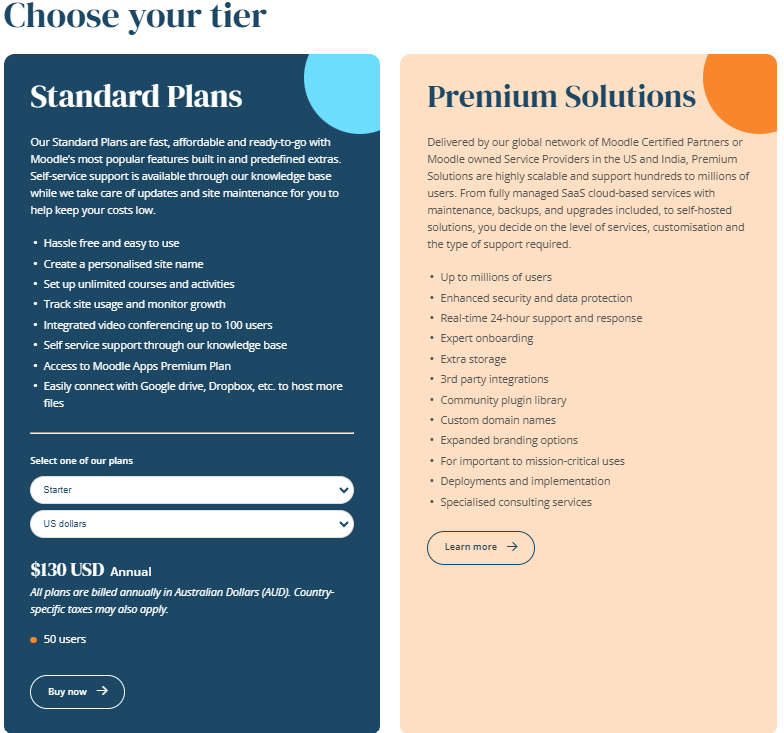
G2 Rating
LMS for Online Courses – Frequently Asked Questions
What are the key differences between a general online training platform and an LMS specifically designed for selling online courses?
An LMS (Learning Management System) specifically designed for selling online courses focuses on robust e-commerce and marketing functionalities.
While general online training platforms may handle content delivery, LMS platforms tailored for course sales include features like flexible pricing options (subscriptions, bundles, discounts), seamless payment gateway integrations (Stripe, PayPal), detailed sales and revenue tracking, and integrated marketing tools for lead generation and promotion.
What essential e-commerce features should I look for in an LMS to ensure smooth course sales and payment processing?
When selecting LMS software, prioritize platforms that offer:
- Support for various payment options (one-time, subscriptions, installments).
- Integration with multiple payment gateways (Stripe, PayPal, etc.).
- Automated invoicing and tax calculations.
- Customizable checkout pages with secure transaction processing.
- Detailed sales and revenue reporting dashboards.
- Ability to apply discounts and coupons.
- Integrated course authoring features for easy creation of training content – common use cases include customer training, compliance training, partner training and more.
How important are learner engagement and interactive features in an LMS, and what specific functionalities should I consider?
Learner engagement is important for achieving the desired learning outcomes for learners. Look for an LMS that provides:
- Interactive course content like quizzes, assignments, and simulations.
- Social learning & communication tools such as discussion forums, live chat, and webinar integrations.
- Gamification elements like badges, leaderboards, and progress tracking.
- The ability to provide certificates of completion.
- Video content with embedded questions.”
Why is website and marketing integration important for an LMS, and what are the benefits of these integrations?
Website and marketing integrations help you expand reach and maximize course sales. Integrations with your existing website (or e-commerce platforms like Shopify/WooCommerce) allow easy & streamlined course publishing and registration. Marketing integrations (email marketing, CRM, analytics tools) enable you to:
- Create targeted marketing campaigns.
- Track lead generation and conversions.
- Automate email sequences and promotions.
- Utilize affiliate programs.
- Maintain brand consistency.
- Have all of your sales and course information in one place
How does Arlo differentiate itself from other LMS platforms mentioned in the article, and what are its key features for online course creators?
Arlo distinguishes itself as an all-in-one training platform that handles in-person, virtual, blended, and elearning courses, with a strong emphasis on comprehensive course management and e-commerce. Key features include:
- Real-time dashboards for tracking performance.
- AI powered course creation, as well as document to course conversion, and scratch built course creation.
- Integrated course management and registration with flexible payment options.
- Automated course communications and reporting.
- Seamless website integration for course publishing.
- Built-in CRM and marketing tools to manage leads and promote courses.
